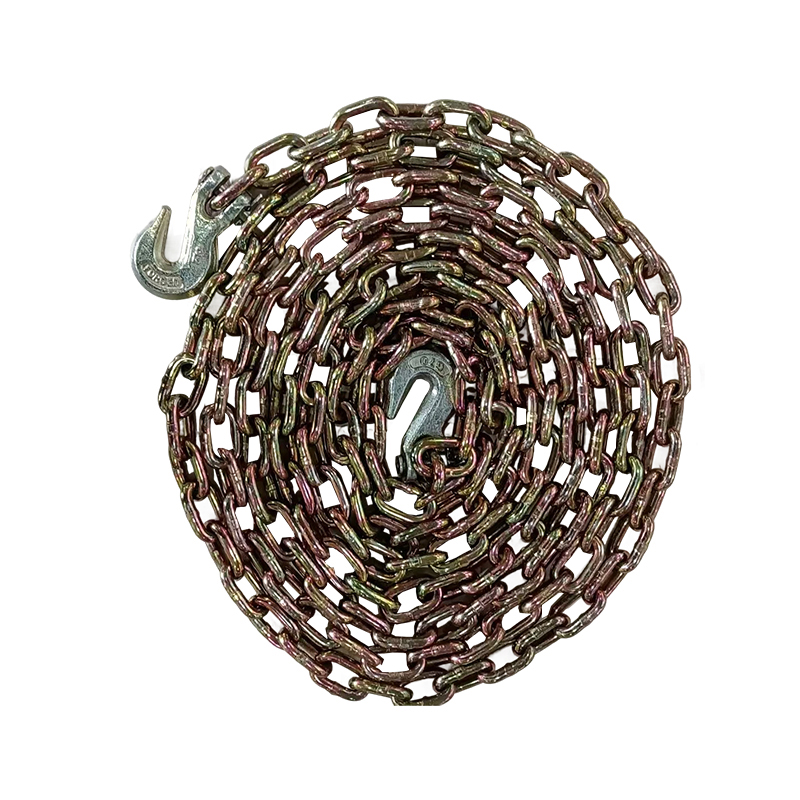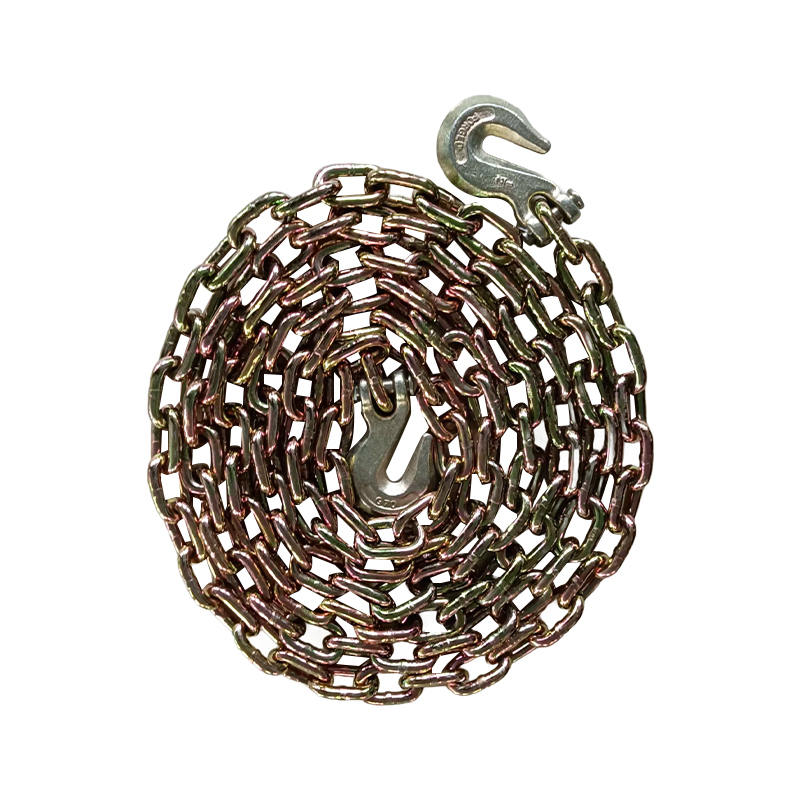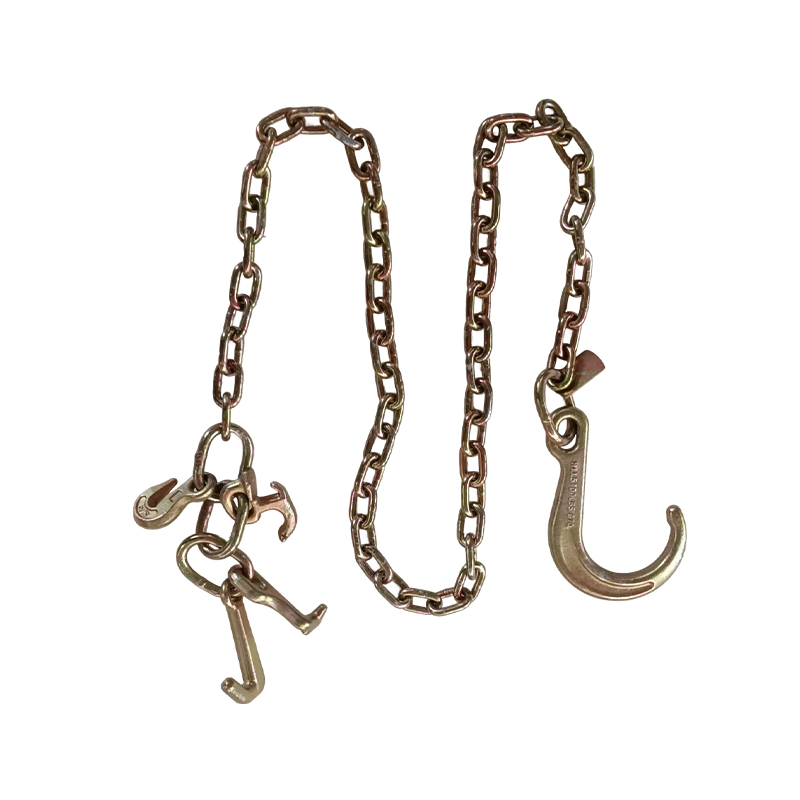How adaptable is the bundling chain in a complex logistics environment?
Release Time : 2025-07-02
In modern logistics and transportation, facing the complex and changeable transportation environment and diversified cargo types, the adaptability of the bundling chain as a key fixing tool is particularly important. Whether it is on a rugged mountain road, a bumpy sea voyage, or in a high-altitude cargo hold, the bundling chain can be flexibly adjusted according to actual needs, showing strong environmental adaptability and task compatibility.
First of all, the design of the bundling chain itself is highly flexible. It can freely adjust the length and width according to different transportation scenarios to adapt to goods of various sizes and shapes. This customizable feature makes the bundling chain not only suitable for neat placement in standard containers, but also for the fixing needs of non-standard equipment, heavy machinery and even irregular-shaped items. Whether the goods are smooth metal surfaces or fragile packaging boxes, the bundling chain can ensure that it is both firm and does not damage the cargo body by replacing appropriate connectors and contact parts.
Secondly, the materials used in the bundling chain have extremely strong pressure resistance, wear resistance and corrosion resistance. During sea transportation, high humidity, heavy salt spray and strong vibration are a severe test for any fixing device. However, the bundling chain can maintain stable performance in harsh environments with its high-strength alloy structure and surface protection treatment, and will not rust and fail due to long-term exposure to humid air. Similarly, when encountering frequent starts, sudden brakes or severe bumps in land transportation, the bundling chain can also firmly lock the goods to prevent sliding or tipping, ensuring transportation safety.
Not only that, the bundling chain also has excellent connection versatility. Its two ends are usually equipped with various types of hooks, buckles, shackles and other connectors, which can quickly connect with the vehicle base, container internal fixing points or other auxiliary lashing equipment. This modular design greatly improves the scope of use of the bundling chain, so that it can not only complete the cargo fixing independently, but also be used in conjunction with other straps and tensioners to form a complete cargo reinforcement system. Especially at logistics nodes that require rapid loading and unloading, this plug-and-play connection method significantly improves operating efficiency and reduces labor costs.
In dealing with extreme weather and emergencies, the bundling chain also performs well. For example, when encountering heavy rain, strong winds or low temperature and snowy weather, traditional ropes may fail due to water absorption and expansion, ice hardening or aging and breaking, while bundling chain is not easily affected by the environment due to its material characteristics, and always maintains stable mechanical properties. Even after long-term static or repeated use, it can still ensure sufficient load-bearing capacity and operational safety. This stability is crucial for long-distance transportation, especially cross-border multimodal transportation, because it means that the goods can be consistently protected at every link in the entire transportation chain.
In addition, the ease of operation and reusability of bundling chain are also one of its important advantages in adapting to complex logistics environments. Compared with disposable strapping or fragile hemp rope, bundling chain can be disassembled and installed multiple times without affecting its function, which not only reduces transportation costs, but also reduces resource waste. At the same time, due to its simple and intuitive structure, operators can master the use method without complex training, which is particularly beneficial for temporary deployment, emergency transportation and other situations.
From a management perspective, bundling chain has a high degree of standardization, which is convenient for unified procurement, inventory and scheduling. Logistics companies can pre-configure bundling chains of corresponding specifications according to different transportation tasks, and centrally recycle and maintain them after use, so as to achieve efficient material management and process control. This systematic operation mode helps to improve overall operational efficiency and enhance the company's adaptability and service quality in the highly competitive logistics market.
In summary, the reason why the bundling chain can show excellent adaptability in the complex and changing logistics environment is due to its flexible and adjustable design, sturdy and durable materials, diverse connection methods, good environmental stability and simple operation experience. Whether facing space constraints, weight challenges, or time pressure, the bundling chain can provide efficient, reliable and sustainable solutions, becoming an indispensable and important part of the modern transportation system. With the continuous expansion of the global logistics network and the continuous advancement of technology, the application value of the bundling chain will be further highlighted, bringing safer and more efficient guarantees to various transportation scenarios.
First of all, the design of the bundling chain itself is highly flexible. It can freely adjust the length and width according to different transportation scenarios to adapt to goods of various sizes and shapes. This customizable feature makes the bundling chain not only suitable for neat placement in standard containers, but also for the fixing needs of non-standard equipment, heavy machinery and even irregular-shaped items. Whether the goods are smooth metal surfaces or fragile packaging boxes, the bundling chain can ensure that it is both firm and does not damage the cargo body by replacing appropriate connectors and contact parts.
Secondly, the materials used in the bundling chain have extremely strong pressure resistance, wear resistance and corrosion resistance. During sea transportation, high humidity, heavy salt spray and strong vibration are a severe test for any fixing device. However, the bundling chain can maintain stable performance in harsh environments with its high-strength alloy structure and surface protection treatment, and will not rust and fail due to long-term exposure to humid air. Similarly, when encountering frequent starts, sudden brakes or severe bumps in land transportation, the bundling chain can also firmly lock the goods to prevent sliding or tipping, ensuring transportation safety.
Not only that, the bundling chain also has excellent connection versatility. Its two ends are usually equipped with various types of hooks, buckles, shackles and other connectors, which can quickly connect with the vehicle base, container internal fixing points or other auxiliary lashing equipment. This modular design greatly improves the scope of use of the bundling chain, so that it can not only complete the cargo fixing independently, but also be used in conjunction with other straps and tensioners to form a complete cargo reinforcement system. Especially at logistics nodes that require rapid loading and unloading, this plug-and-play connection method significantly improves operating efficiency and reduces labor costs.
In dealing with extreme weather and emergencies, the bundling chain also performs well. For example, when encountering heavy rain, strong winds or low temperature and snowy weather, traditional ropes may fail due to water absorption and expansion, ice hardening or aging and breaking, while bundling chain is not easily affected by the environment due to its material characteristics, and always maintains stable mechanical properties. Even after long-term static or repeated use, it can still ensure sufficient load-bearing capacity and operational safety. This stability is crucial for long-distance transportation, especially cross-border multimodal transportation, because it means that the goods can be consistently protected at every link in the entire transportation chain.
In addition, the ease of operation and reusability of bundling chain are also one of its important advantages in adapting to complex logistics environments. Compared with disposable strapping or fragile hemp rope, bundling chain can be disassembled and installed multiple times without affecting its function, which not only reduces transportation costs, but also reduces resource waste. At the same time, due to its simple and intuitive structure, operators can master the use method without complex training, which is particularly beneficial for temporary deployment, emergency transportation and other situations.
From a management perspective, bundling chain has a high degree of standardization, which is convenient for unified procurement, inventory and scheduling. Logistics companies can pre-configure bundling chains of corresponding specifications according to different transportation tasks, and centrally recycle and maintain them after use, so as to achieve efficient material management and process control. This systematic operation mode helps to improve overall operational efficiency and enhance the company's adaptability and service quality in the highly competitive logistics market.
In summary, the reason why the bundling chain can show excellent adaptability in the complex and changing logistics environment is due to its flexible and adjustable design, sturdy and durable materials, diverse connection methods, good environmental stability and simple operation experience. Whether facing space constraints, weight challenges, or time pressure, the bundling chain can provide efficient, reliable and sustainable solutions, becoming an indispensable and important part of the modern transportation system. With the continuous expansion of the global logistics network and the continuous advancement of technology, the application value of the bundling chain will be further highlighted, bringing safer and more efficient guarantees to various transportation scenarios.







